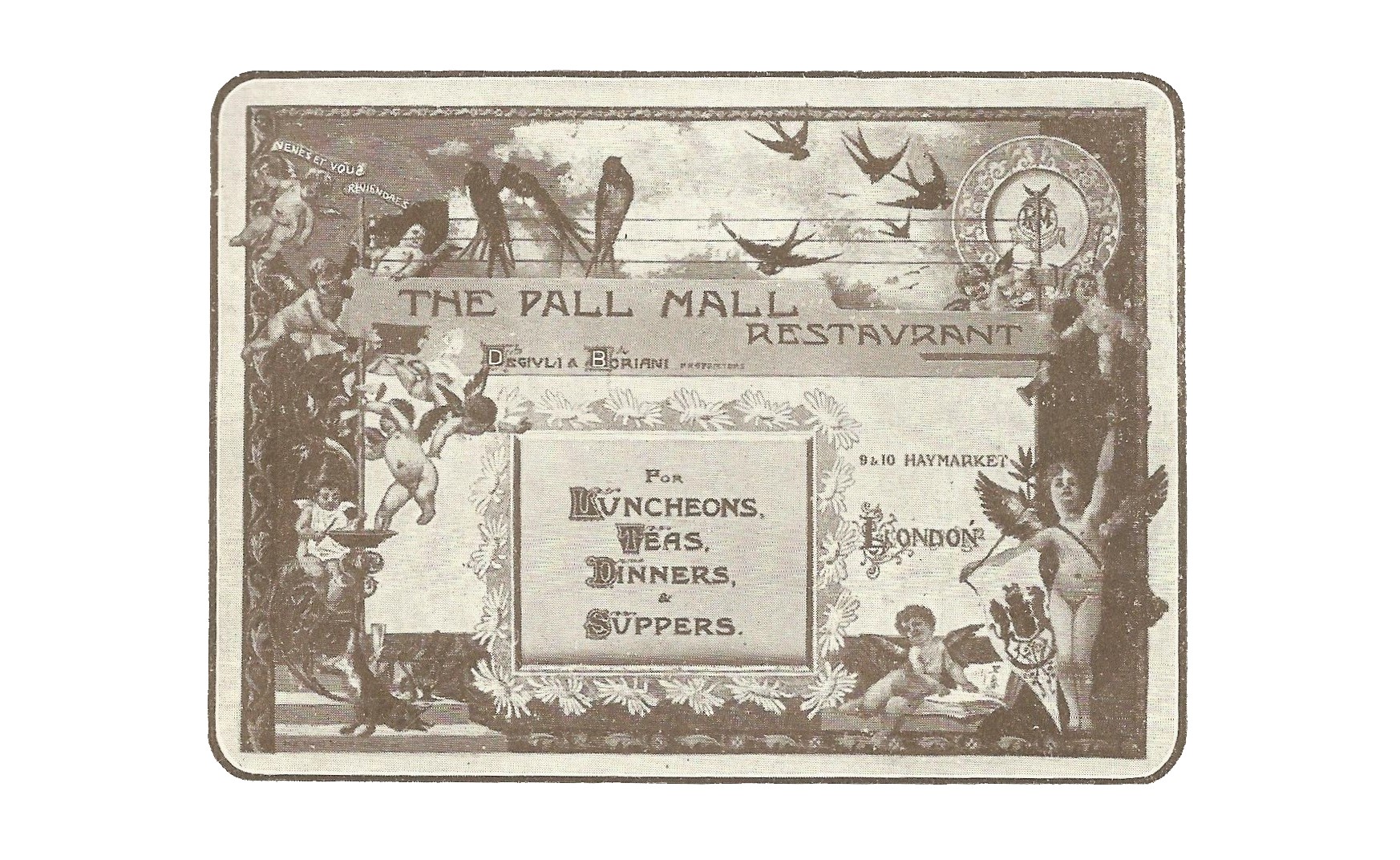
Chancing across a 1913 pamphlet outlining the history of the Pall Mall Restaurant, I was puzzled to find its location given as Haymarket, adjacent to the Theatre Royal. Fans of Rugby Union may be aware of the sport’s connection to the Pall Mall, but this is commemorated by a plaque on Cockspur Street, around 200 metres to the south. So, is there simply an address confusion? Or were there perhaps two hostelries of that name?
Well, it turns out there were three. Allow me to provide a brief history, with a few anecdotes thrown in.
A New Concept in Restaurants
The first Pall Mall opened in 1866 in ornate premises designed by acclaimed architect John Nash fifty years earlier. The building had a triple facade: To the north it faced Pall Mall East, to the south Cockspur Street, while the main entrance faced the rear end of a horse – an equestrian statue of King George III to the west. The idea behind the new venture was to offer the facilities of a gentlemen’s club within a public restaurant. It had the largest public dining room in London, lit by 6 vast windows each 20ft high and 10ft wide, along with private dining rooms, a billiard room, a coffee room for men and another exclusively for women with a private entrance on Pall Mall East.
Immediately, the proprietors set to work on marketing: A temporary Pall Mall dining salon at Epsom racecourse erected for the Derby secured the custom of the Prince of Wales, later Edward VII. Advertising in the better newspapers stated it was located close to “all places of amusement” and catered for private parties. With this publicity, the Pall Mall quickly became a popular location for military, legal and political banquets. A newspaper article of 1869 also suggested that men driven out of their London clubs by summer repair and decorating works could opt for the Pall Mall, “where you can get everything, provided you are willing to pay for it”. This ambiguous phrase may have been a reference to prostitution, endemic in Haymarket nearby and destined to cause problems for the Pall Mall a decade later.
1870 saw the first of many recorded brushes with the law, although this involved booze, not ladies of easy virtue. A summons for serving alcohol during prohibited hours was heard at Bow Street magistrates court, but dismissed after the court failed to determine whether those seated with drinks at 1:20am had bought them after 1am, when service should have finished. Some newspapers were outraged at the police action; the Daily News considered it harassment of a respectable establishment.
The Pall Mall’s great claim to fame occurred the following year, on 26 January 1871. A meeting attended by 21 clubs and schools resulted in the formation of the Rugby Football Union (‘RFU’). No doubt inspired by this, a steamroller parked outside the restaurant eight months later behaved like a classic prop forward: Left unattended while its operator went to get lunch, it was started by a mischievous child, who then jumped off. Slowly and haphazardly it moved off down the street, almost ramming the statue of George III before suddenly picking up speed, turning sharply and demolishing the shopfront of a photographic colourist.
→ The RFU plaque.
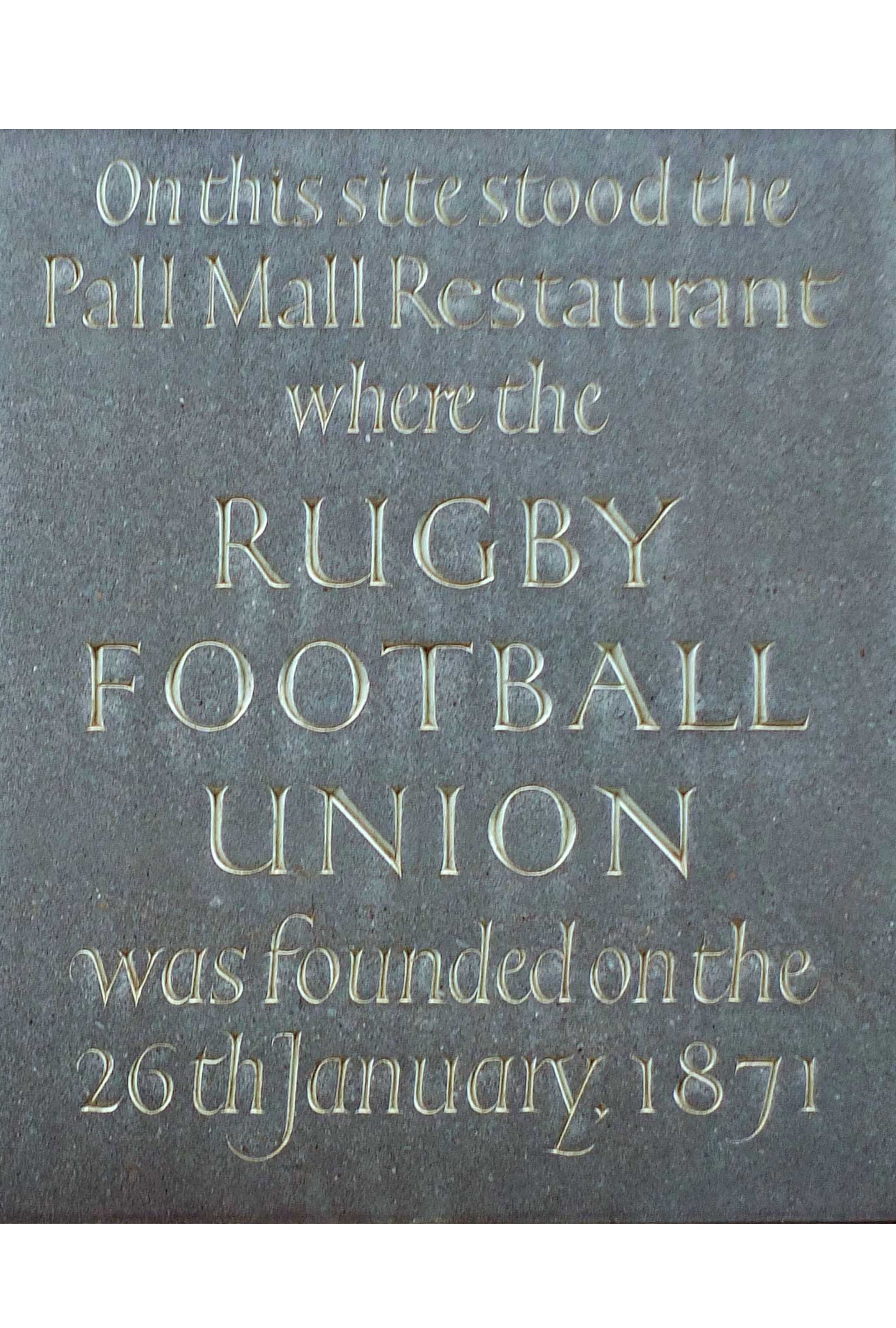
In 1872, an Epicurean club named ‘the Knife and Fork’ was founded at the Pall Mall amid a sumptuous feast, but was never heard of again. Its stated aim was to spread the cultivation of good but economical cookery among the ‘middle and humbler classes’. A worthy purpose, but a group of upper-class men getting the campaign started with a dinner the ‘humbler classes’ couldn’t dream of emulating probably deserved to fail.
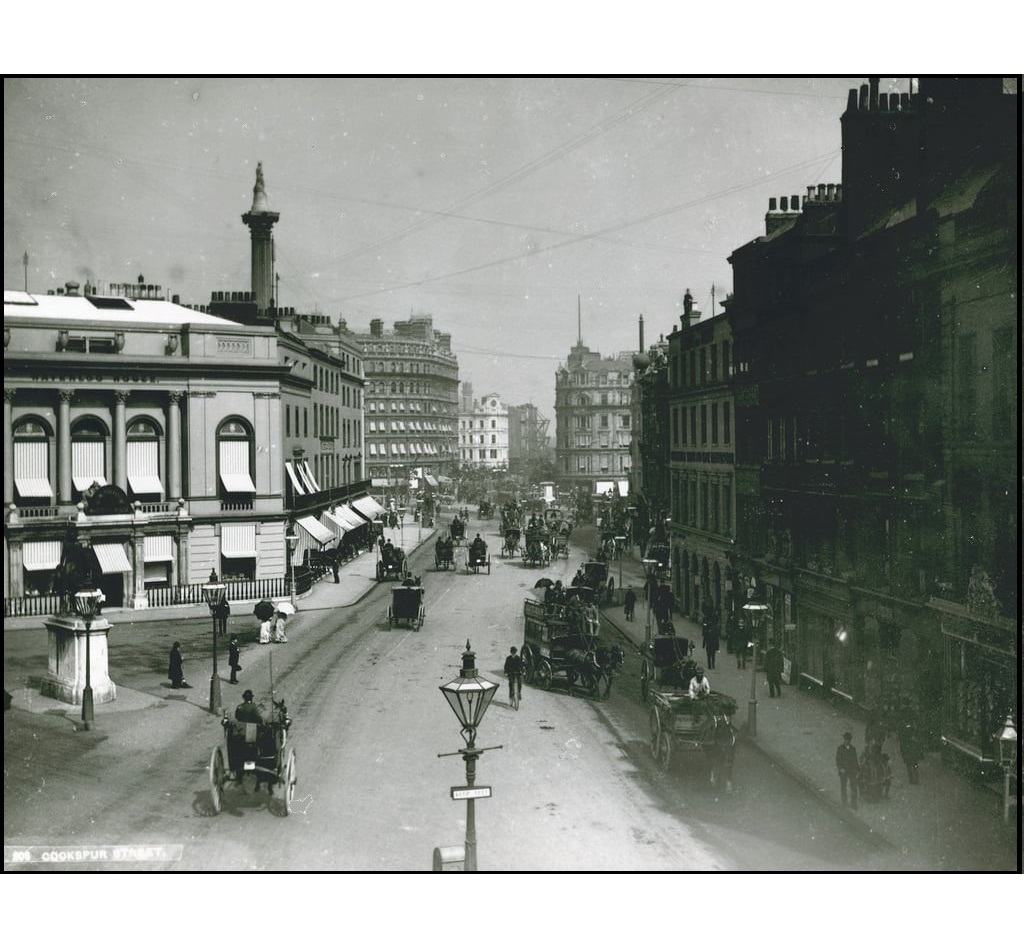
In 1874, the Pall Mall had to leave Cockspur Street as the premises were to be converted into a bank. The bank didn’t last long; just three years later the building was taken by a neighbouring draper’s store, Halling, Pearce and Stone. Halling’s building was known as Waterloo House, and that name was extended to the newly acquired wing.
← The former Pall Mall Restaurant, by now part of Waterloo House, is on the left of the image. Nelson’s Column rises above the rooftops in the background. This view dates from the 1890s.
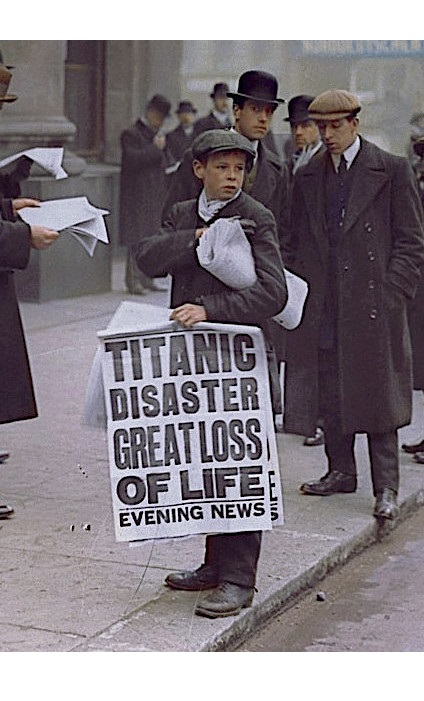
At the turn of the 20th century Waterloo House was demolished, and what rose on the site is perhaps more famous than its predecessor due to a single photograph. Cockspur Street was the home of shipping and railway companies, and the new Oceanic House was the London office of the White Star Line. When RMS Titanic sank in 1912 newspaper boy Ned Parfett rushed there, calculating correctly that he would sell more copies outside Oceanic House than at his usual pitch.
← Ned Parfett. He enlisted in 1916 and died aged 22 in France, just days before the 1918 armistice.
→ Oceanic House today
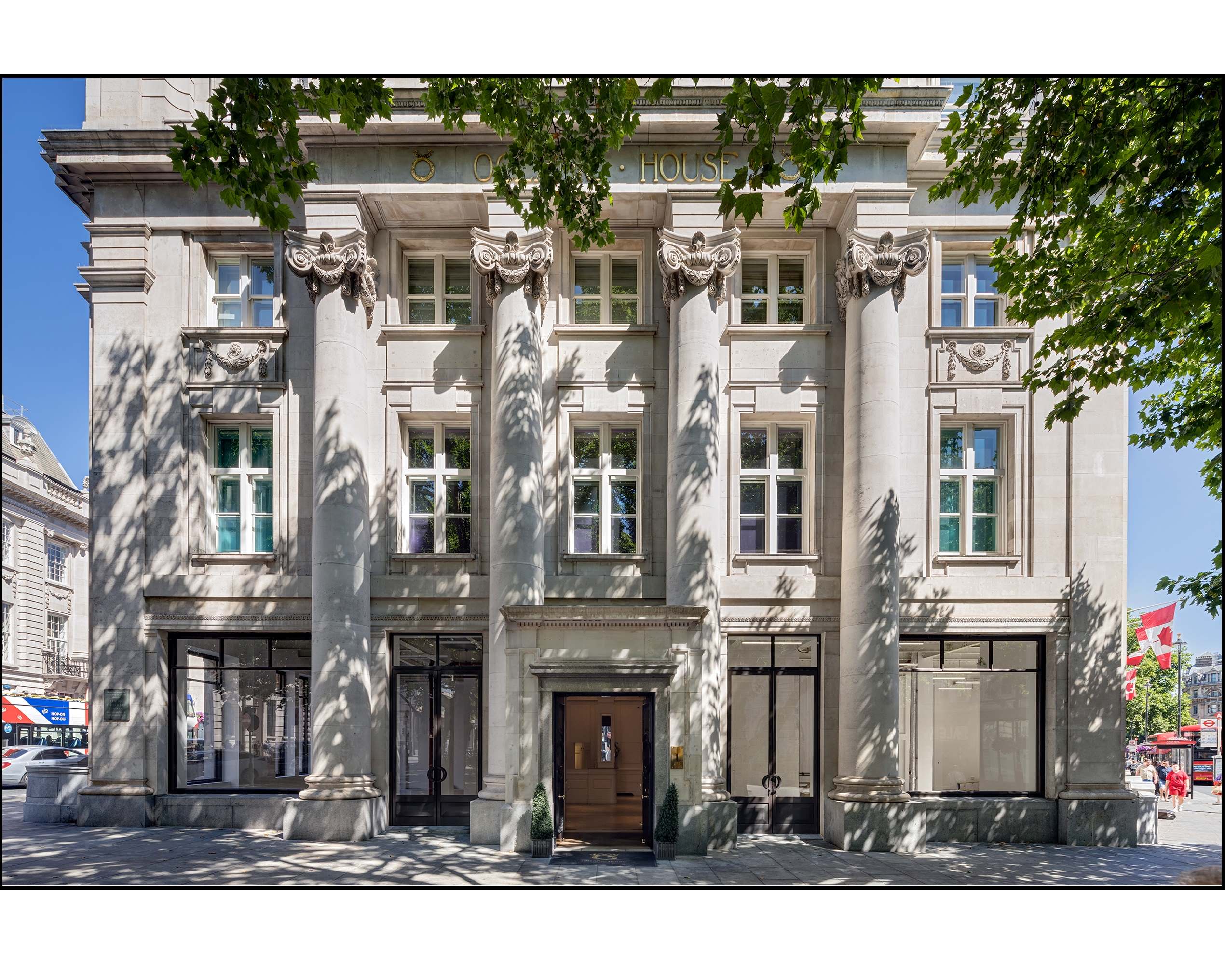
Oceanic House is now home to a ground floor ‘retail opportunity’ with seven residential apartments above. Interested? The 2-floor 4-bed penthouse is for sale at the time of writing [August 2023], at the recently reduced price of £12.95 million.
More Nash, No Cash: A Disastrous Relocation
The evicted restaurant reopened in 1874 at 14 Regent Street, between Piccadilly Circus and Waterloo Place. This was part of Dorland House, a grand building of 1824 that, like the Pall Mall’s first home, had been designed by John Nash. Indeed, No.14 had been Nash’s final London home. His first-floor picture and sculpture gallery had later been converted into the Royal Gallery of Illustration, a theatre in all but name run by Mr & Mrs German Reed. They sought to attract punters frightened by the bad reputation of actors, putting on genteel and inoffensive ‘entertainments’. The project was a success but the couple’s lease expired in 1873 and they had moved elsewhere.
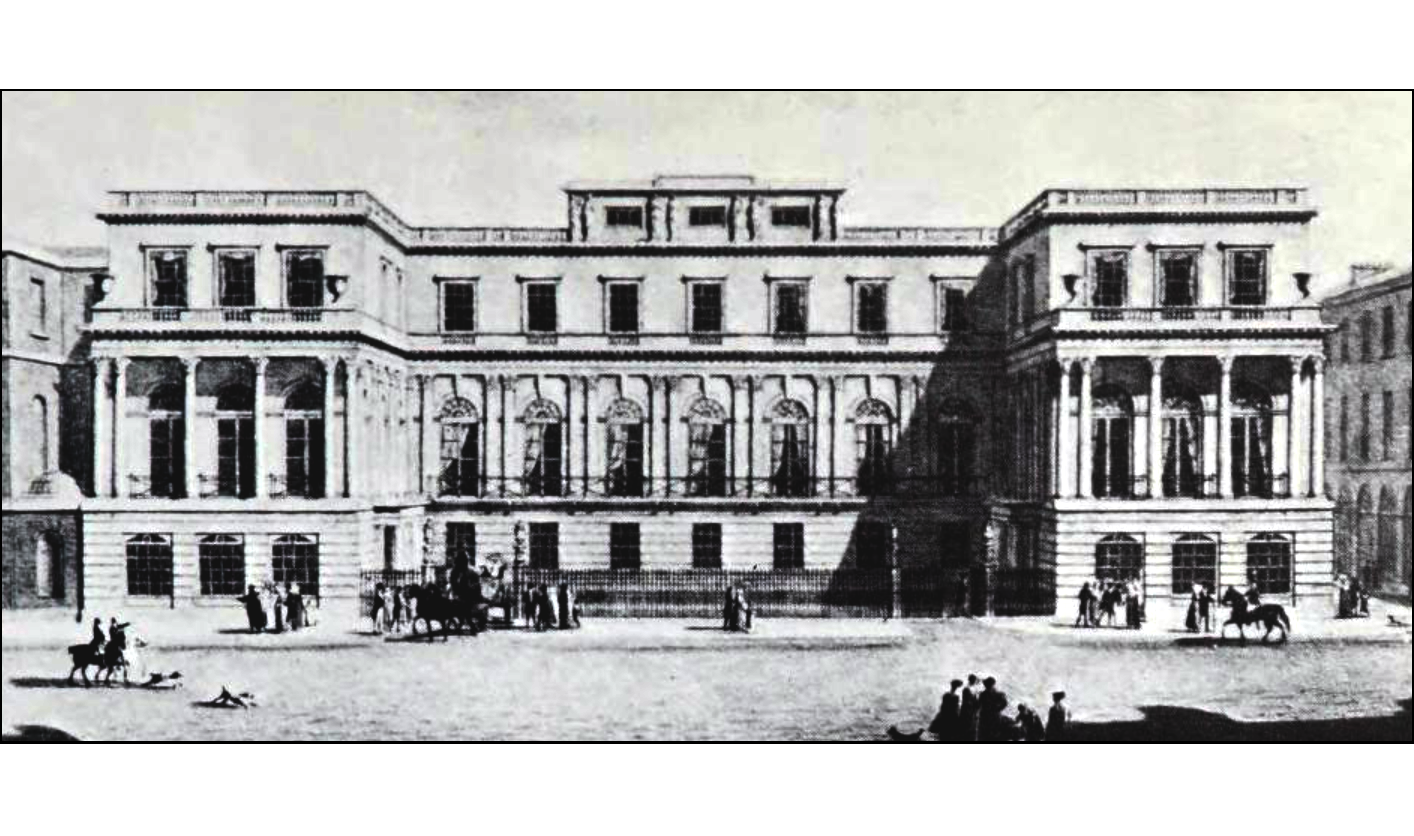
← 14 Regent Street was the southern (right) wing of Dorland House. The centre and north wings were for many years occupied by the Raleigh Club, an establishment for explorers who thought the Travellers Club insufficiently adventurous.
This image, from 1838, is by architect Augustus Pugin, ironically a neo-gothic fanatic and no fan of Nash’s neo-classicism.
The relocated restaurant was initially a success, particularly with regimental dinners, but what happened next would certainly have got Mr German Reed tut-tutting. In 1875 there was an infamous contretemps with the police over after-hours drinking involving a dinner party of actors hosted by Henry Irving. Irving’s generous hospitality meant the party continued way past licensed hours. When the police arrived an argument erupted and one guest, the Lyceum manager ‘Colonel’ H.L. Bateman, got extremely belligerent. He only calmed down once he was safely sipping a nightcap at his club. However, the next day he took to his bed and died in the evening – ironically as his daughter was on stage at the Lyceum acting Ophelia, who laments her father Polonius’ death.
Between periodic visits from the police, the restaurant remained busy. In 1877 Pedro II, Emperor of Brazil, dropped in for breakfast incognito. British royalty were frequent visitors, particularly at the regimental dinners where they were often guests of honour. The Savage Club dined there in 1879 with guests including members of the Comédie-Française and W.E. Gladstone. In the same year the restaurant accommodated next-door neighbour the Raleigh Club while its clubhouse was undergoing renovations. Given the Raleigh catered exclusively to genuine explorers this arrangement seems distinctly unambitious on their part.
Popular as the Pall Mall was, storm clouds were gathering. Both the Raleigh Club and the restaurant were backed by three brothers, the Ewens, and the family was facing financial ruin. One brother, Thomas, was heading towards bankruptcy at the end of 1879 with debts of £60,000 (£6m today) linked to the two businesses. The restaurant’s position deteriorated further in March 1880 when proprietor and licensee, Mr. Draper, involved since its creation in 1866, had another run-in with the police. This time it wasn’t booze but the oldest profession. 14 Regent Street was close to the heart of the high-end prostitution around Haymarket. The police were clamping down and had closed the prostitutes’ usual resort, the Argyll Rooms. As a result, more respectable establishments were being targeted – first by the women, who had nowhere else to go, and then by the police. Draper allowed women ‘of that class’ to stay on the premises without purchasing refreshments. Guilty of ‘permitting his place to be the habitual resort of reputed bad character on at least three occasions’, he was fined £15 plus costs.
Draper was not the only restaurateur to appear before magistrates on this charge, but the verdict must have discouraged his more respectable clientele and it proved to be the final straw. Just two months later bankruptcy proceedings were started against Draper himself, leading to the closure of the Pall Mall. In February 1881, fixtures and fittings went under the hammer. It reopened later, but mainly for meetings rather than dinners; its heyday on Regent Street was over, only seven years after it began.
In 1883 it did host a banquet for Conservative politicians, but only because it was about to become the temporary home of the new Constitutional Club. With that, the public restaurant was gone for good. The club’s residence was brief: It moved to purpose-built premises in 1886, but was replaced at 14 Regent Street a year later by the Junior Constitutional Club, the senior club being oversubscribed. Junior in turn moved out when its new clubhouse opened in 1892. Increasingly derelict, Nash’s former home suffered the indignity of ending its days as a car showroom for French car marque Panhard et Levassor. It was finally replaced in the early 1920s by the imposing bulk of a new office block, also called Dorland House.
→ Dorland House (centre) in 2023.
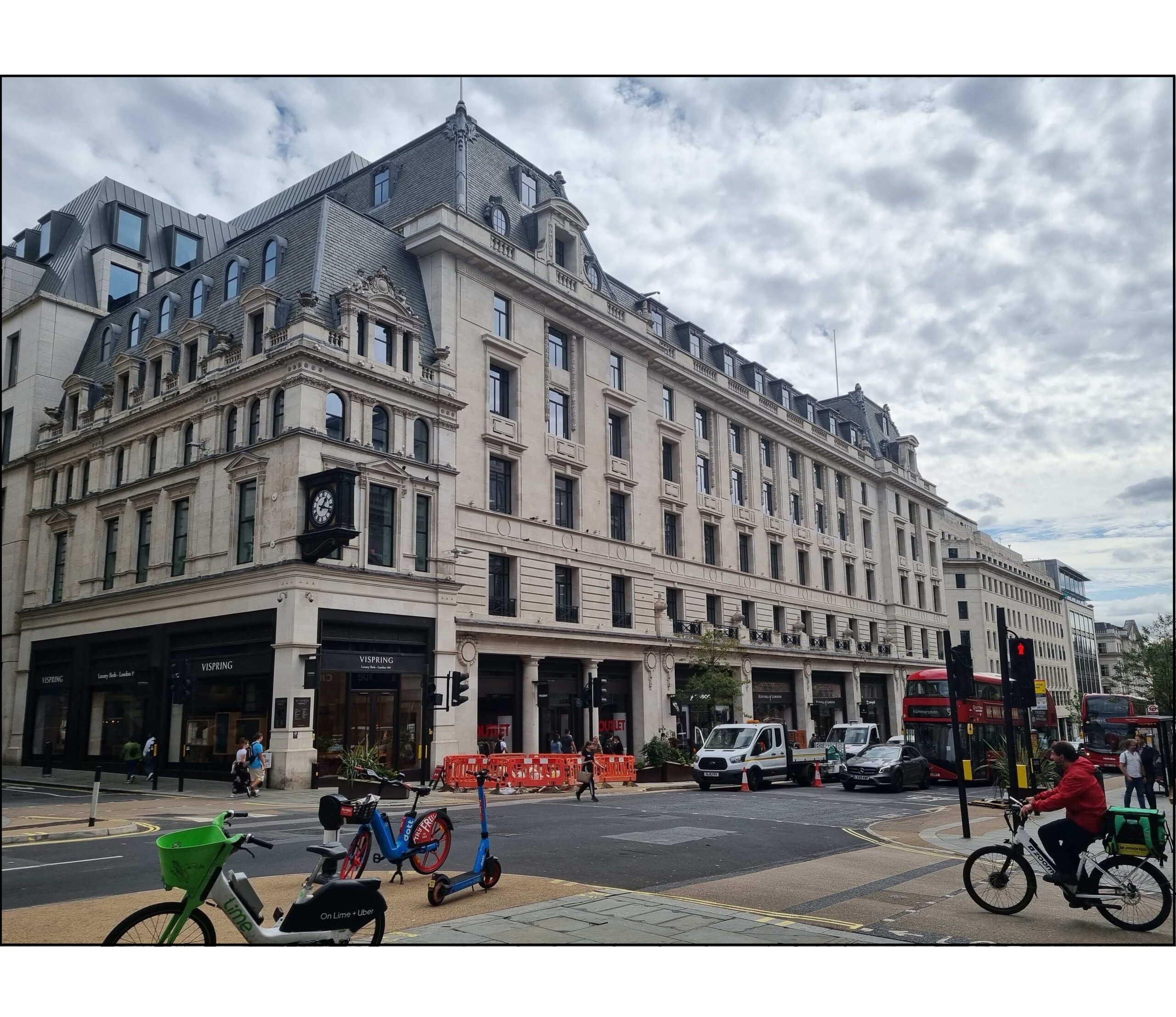
It would be twenty years before the name reappeared, but the restaurant that was to become the third Pall Mall had been founded long before.
Altogether More Respectable: Buckstone’s Ghost, the Dwarf of Blood and Old Polly
In 1821 the majestic Theatre Royal Haymarket, designed by John Nash, opened. Its predecessor, originally known as the ‘Little Theatre in the Hay’, had closed the previous year but still stood, derelict, directly adjacent to the north. With the new playhouse opened the site could be cleared and a building containing three shops (8, 9 and 10 Haymarket) was constructed. A decade later 9 and 10 had become the Café de l’Europe. Despite its name this was an intimate establishment firmly focused on English fare, with the added attraction of a small buffet-bar at the front of the building. It specialised for many years in post-theatre suppers for the audiences and casts of the theatres close by, until the same police crackdown that did for 14 Regent Street began restricted its hours.
It was lucky to survive beyond the 1880s: As well as the restricted licensing hours killing off lucrative business, Sir Squire Bancroft, actor-manager at the Theatre Royal, hatched a plan to extend the theatre over the site of the restaurant. The plan didn’t proceed only because his business partners – fellow actors – got cold feet at the last moment. Then in the 1890s the latest owner, Mr. Pentecost, faced with the demolition of another restaurant he owned nearby, transferred its name, Epitaux’s, to the Cafe de l’Europe.
Enter retired soldier, food critic, journalist and dramatist Lieutenant-Colonel Nathaniel Newnham-Davis, known from his byline on the Sporting Times as the ‘Dwarf of Blood’. He was ever reliable for some oh-so-polite comments on both restaurant and his dining companion, whose true identity was usually not revealed. For his visit to Epitaux’s the companion was a young American actress referred to only as ‘Miss Belle’. Newnham-Davis started by reminiscing about the old Epitaux, recalling that in the 1840s it had been the only place in London serving decent French cuisine. The Duke of Wellington, who famously had worked in France, was frequently seen dining there as a result. As for the new Epitaux, Newnham-Davis waxed eloquent on the decoration of the dining room – white plasterwork picked out in gold, blue-green velvet and many palms – but less so on Miss Belle (“pretty”). He noted how small the establishment was, lacking as it did even a decently-sized lobby. The table d’hote menu he opted for was mostly French in inspiration, and he washed it down with Mumm champagne. While complimenting most dishes, he lamented the temperature of the whitebait and opined that the chef must have had “a little accident with the salt-cellar in preparing the croûte au pot”. Total cost for two, including champagne, £1 12s (about £170 today).
→ Lieutenant-Colonel Newnham-Davis, the ‘Dwarf of Blood’. His military career took him all over the world, as did his restaurant reviews.
Despite the compliments, Epitaux was short-lived. A new owner swept it to bankruptcy and in January 1902 it reopened as the Pall Mall. A year later, Pietro Degiuli and Alberto Formaggia took it on, gave it the motto, “Venez et vous reviendrez” (“Come and you will return”) and ensured that one or two Italian dishes always appeared on the menu alongside the French. Maître d’ Francesco Boriani later became Degiuli’s partner, replacing Formaggia, and it is this pairing that made the Pall Mall’s reputation. Miss Helen Macdonald, known as ‘Mac’, became manageress of the buffet-bar and forbade entry to all women except ‘Old Polly’, a Piccadilly flower-seller who sold buttonholes to customers. There was clearly quite some camaraderie among the clientele for in 1909 an appeal was set up following an earthquake in Italy, and the proprietors raised over £67 (£6,500 today). This was probably why, in 1911, Boriani was made a chevalier of the royal order of the crown of Italy.
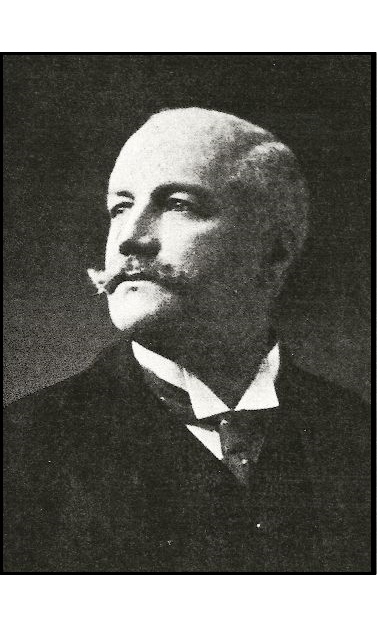
The Sphere claimed of this new Pall Mall that the main restaurant was a good place to take maiden aunts visiting from the country – suggesting a change in mood from when Newnham-Davis entertained ‘Miss Belle’. The bar remained a haunt of bohemian turf and theatrical types, but this time – with Mac keeping a watchful eye – there would be no incidents to damage its respectability. It was a success from start to finish.
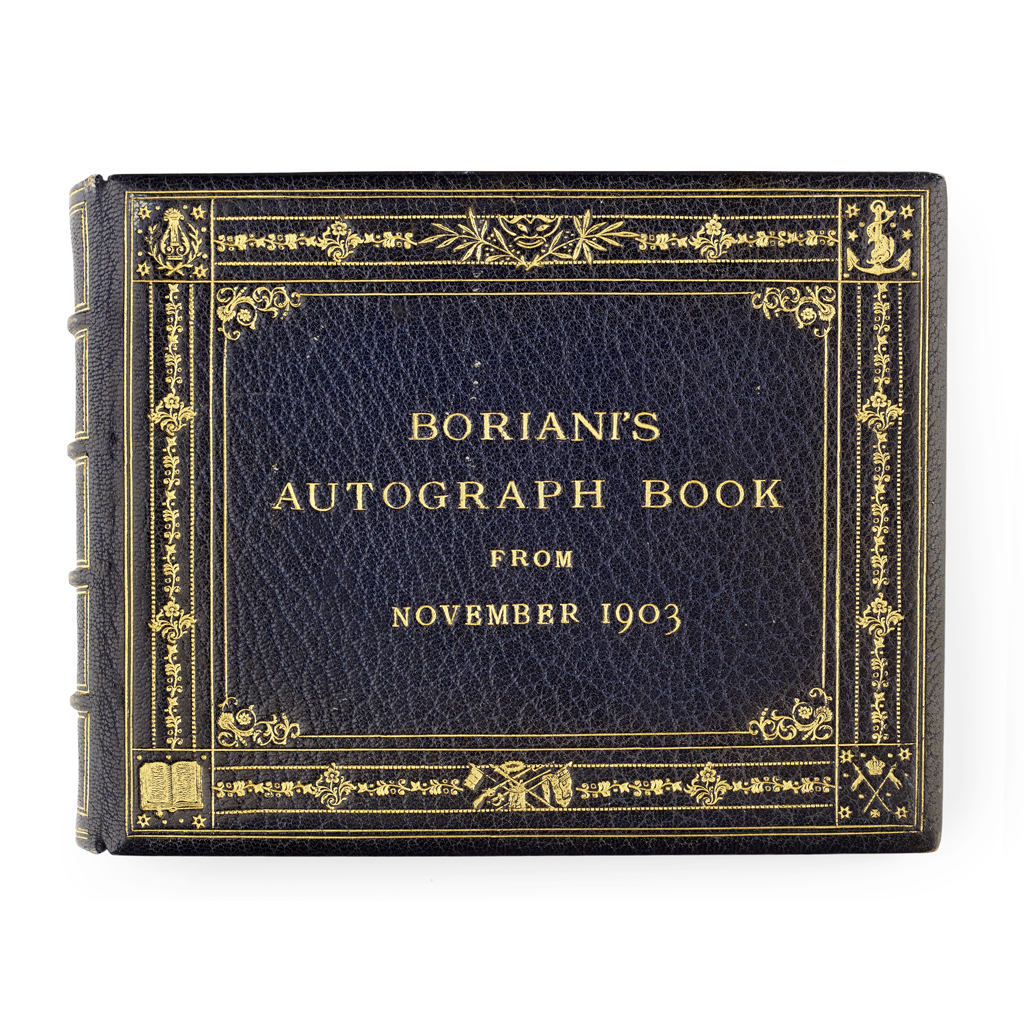
Boriani kept an autograph book of famous clients, full of witticisms. Adelina Patti [opera singer] wrote that “A beautiful voice is the gift of God,” Yvette Guilbert [cabaret singer] added that “An ugly voice is also the gift of God”; Sir Herbert Tree [actor] then wrote that a voice was “A visitation of Providence” and Mary Anderson [actress] added “All things are the gift of God”. Sir Rider Haggard [novelist] shot down the thread with “But the greatest gift of God is silence.”
A rare signature is that of Guglielmo Marconi. Newnham-Davis suggests this was coaxed from him by Boriani’s wit. On the menu he had included “Haricots verts à la Marconi.” Marconi asked why they were so named. Boriani said he hoped the beans weren’t stringy. Marconi confirmed they weren’t, and Boriani replied that they could thus be described as “Sans fil” (wireless).
Newnham-Davis helpfully supplies a description of the refurbished restaurant after a later visit: A colour scheme of white and deep pink; a musician’s gallery at one end surviving from the 1850s now used by diners; a banqueting room made possible by the departure of the Fly Fishers’ Club from No.8, which became part of the Pall Mall. There was also a private dining room and, no doubt to his great relief, a lobby/waiting room – also part of No.8.
→ The Pall Mall’s banqueting room hosting a dinner for the Order of Napoleon, June 18th 1910.
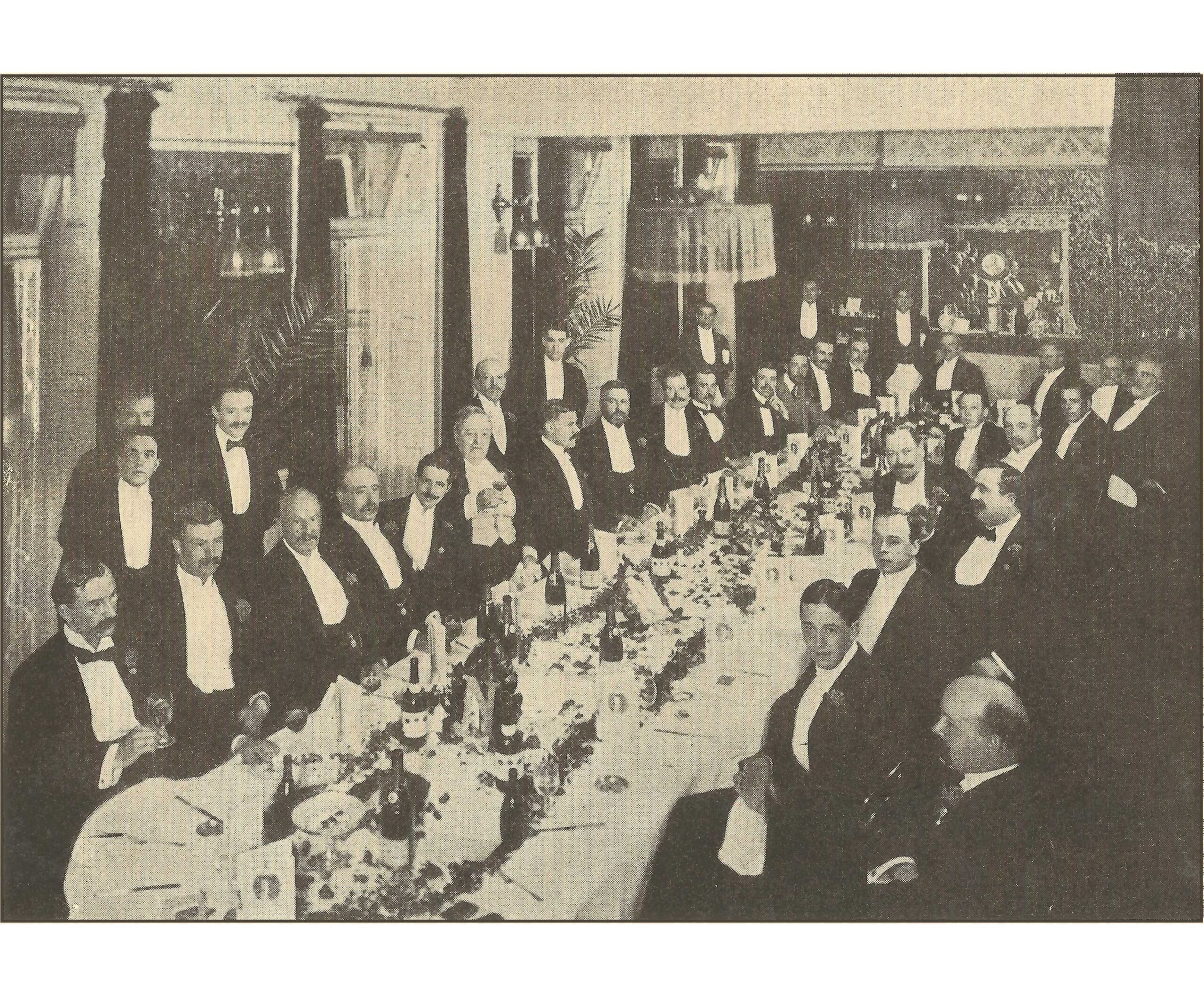
In 1917 its reputation was enhanced among its clientele when Degiuli was fined £20 5s for breaching rules on the quantity of meat served, the portions being over-generous in the face of increasing war-time regulation. After that, in the early post-WW1 years, the Pall Mall managed to reclaim some of the regimental dinner business secured by its Regent Street predecessor. But success couldn’t guarantee survival: Time, and in particular the lease, was running out. If the third incarnation had anything in common with its predecessors, it was the inevitability of demolition – and this time there would be no relocation.
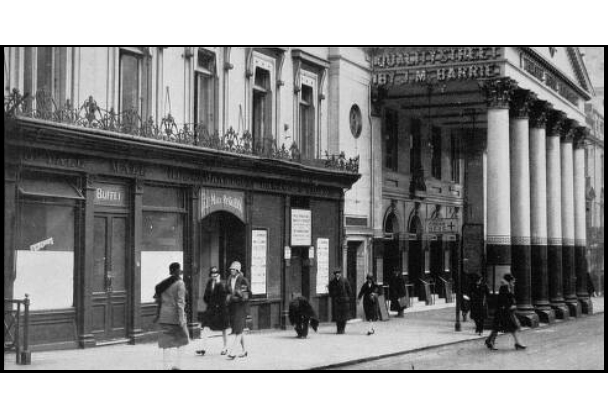
Degiuli, who lived ‘above the shop’ died in 1927. The lease expired in 1929 and the restaurant closed. The entire contents – including 250 cases of champagne – were auctioned off, and demolition followed in 1930. The extraordinary autograph book stayed in private hands; in 2018 it was sold at auction for £2,625. Mac managed the buffet-bar until the very end, then moved on to the Westminster Theatre before dying in 1955.
← The third Pall Mall Restaurant in 1929, closed and awaiting demolition. To the right is the portico of the Haymarket Theatre Royal.
Allegedly, the demolition also had one curious side-effect. One-time manager of the Theatre Royal John Buckstone (died 1877) was said to harmlessly haunt the theatre using a private staircase. Herbert Tree, a later manager, decided to demolish the staircase but this didn’t stop Buckstone. Only the destruction of the Pall Mall Restaurant seemed to dampen this particular spirit. One theory was that the ghost was fond of nipping into the basement of the restaurant for a quick drink in between acts, and gave up the haunting game when he was deprived of his tipple.
→ The site today. It remains a place of refreshment and is currently occupied by a high-end Indian fusion restaurant, the Farzi Café.
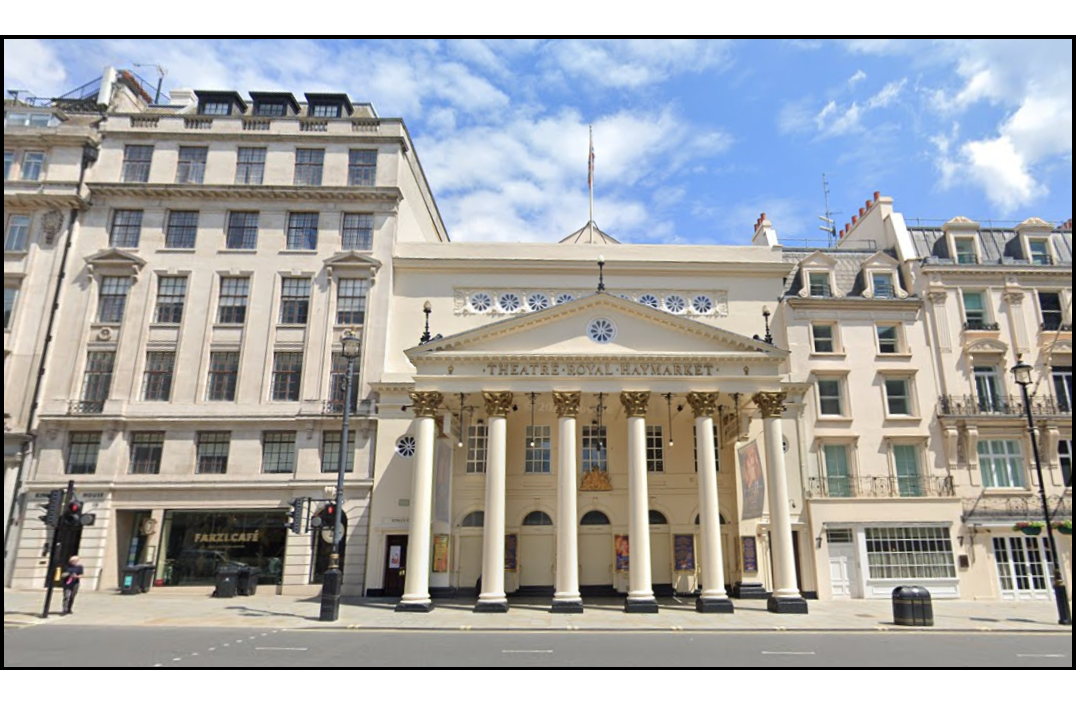
There is probably no-one alive who dined at the Pall Mall Restaurant, and the name is only mentioned these days in connection with the founding of the RFU. It seems there is no way back. However, rumour has it that Patrick Stewart saw the ghost of Buckstone in the wings of the Haymarket Theatre Royal in 2009. If a ghost can be revived, so too perhaps can a restaurant.

Nearest Stations:
Selected Bibliography:
Credits: